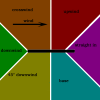EdFred
Taxi to Parking
Because non-towered airports work by the cooperation of all pilots. The FAA has established through convention that a 45 degree entry to downwind is the "best" way to enter the pattern and published guidance to that effect in the AIM and other official publications. Yes, the AIM is only regulatory through 91.13.
You can enter the pattern almost any way you want, but if you cause problems in the air by doing it, you are in the wrong. Based on on the non-regulation guidance on the issue, causing a problem by not doing a 45 degree entry implies liability.
Yes, the FAA in all their infinite stupidity recommends turning your back to the airport and losing visual contact with the field, and all the traffic you previously acquired. No thanks. The only time I do a 45 is when I happen to be coming from that direction. I personally think anyone using this asinine recommendation should be violated under 91.13.
I tell my students that it is the most retarded entry, but that's what I'm going to show you to do, because the retards at the FAA recommend it. After you pass your check ride, please don't do it anymore.






